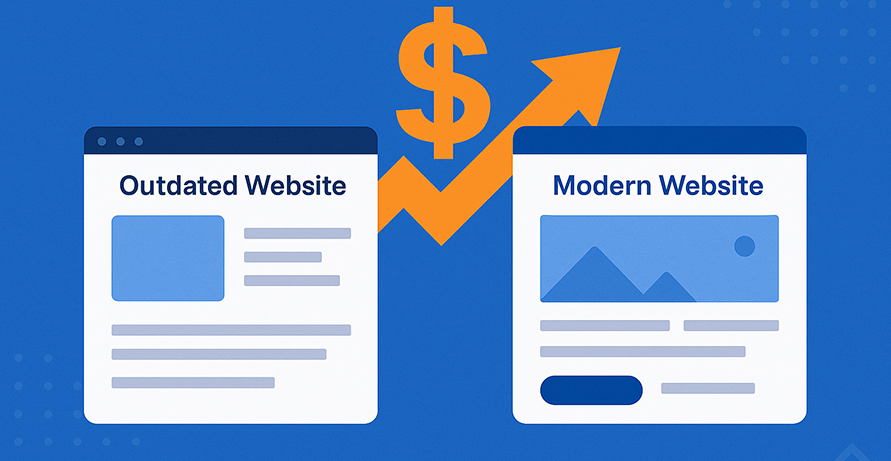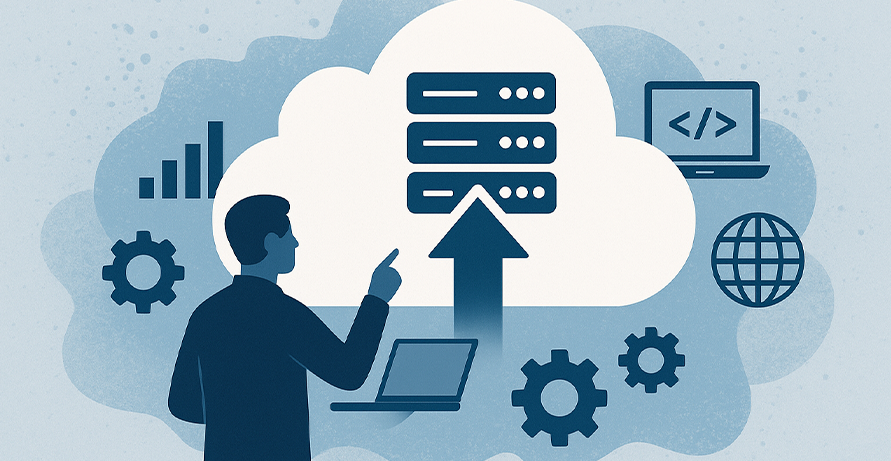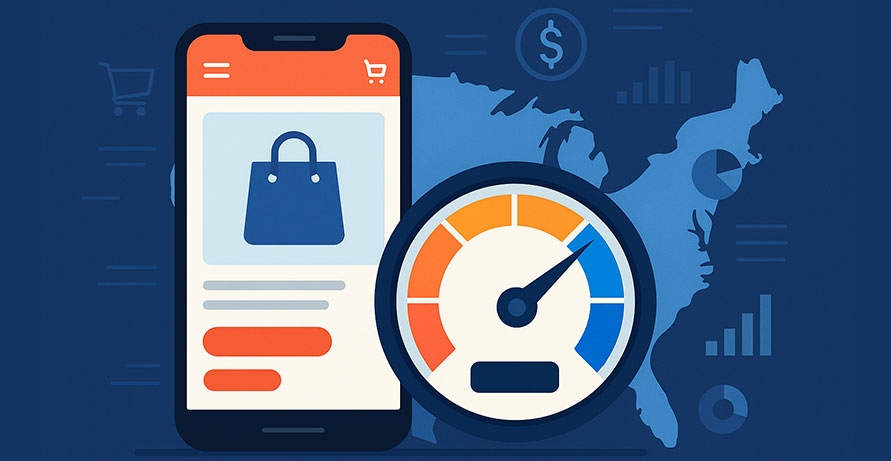The True Cost of Ignoring Website Modernization in 2025

In 2025, digital performance is directly tied to business revenue, user trust, and brand survival. Yet many U.S. companies still operate outdated websites that slow growth, repel customers, and weaken security. Ignoring modernization is no longer a cost-saving tactic; it is a silent profit killer.
This blog explores the real financial and operational costs of neglecting website modernization, supported by market data and case studies. You will also learn how Anchor Points helps U.S. businesses modernize their web infrastructure through scalable, secure, and high-performing digital solutions.
Why Website Modernization Matters More Than Ever
In 2025, users expect instant, personalized, and seamless web experiences. According to Google’s latest Core Web Vitals report, a one-second delay in page load can cut conversions by 7 percent. Meanwhile, 88 percent of consumers say they are less likely to return to a website after a bad experience (HubSpot, 2024).
An outdated site is more than an aesthetic issue; it affects every layer of your business:
- Performance: Slow websites drive away visitors and reduce SEO ranking.
- Security: Outdated platforms are three times more likely to be hacked.
- Conversion: Modern UX and faster checkout increase revenue potential.
- Scalability: Legacy systems struggle to integrate with modern CRMs, AI, or cloud APIs.
Author’s Expert Viewpoint:
At Anchor Points we’ve seen countless U.S. businesses lose traffic, revenue, and data integrity simply because they postponed modernization. A website that has not been updated in three years is already falling behind.
The Hidden Financial Costs of an Outdated Website
Ignoring modernization has measurable financial consequences that go beyond maintenance.
1. Lost Revenue from Poor Performance
Speed and usability directly impact sales. Google found that 53 percent of mobile users abandon a site if it takes more than three seconds to load. Slow websites also lower search rankings, reducing visibility to potential buyers.
Case Example:
An online retailer in Texas experienced a 35 percent traffic drop when their site performance score fell below 60 on Google PageSpeed Insights. After modernization, bounce rates dropped by 40 percent and conversion rates increased by 25 percent.
Anchor Points Integration:
We optimize websites using Core Web Vitals benchmarks, server caching, and next-generation frameworks like React, Next.js, and Drupal 10.
Author’s Viewpoint:
Every millisecond counts. Modernization is not a design upgrade; it is a revenue strategy.
2. Increased Maintenance and Technical Debt
Older websites built on deprecated frameworks such as PHP 5.x, Drupal 7, or WordPress 5 often require custom fixes to stay functional. This leads to mounting technical debt, the hidden cost of patchwork maintenance.
According to Deloitte, 70 percent of IT budgets in legacy organizations are spent just on maintaining old systems instead of innovation.
Anchor Points Integration:
We migrate clients from outdated stacks to cloud-native architectures with modular components. This drastically cuts future maintenance costs and improves update cycles.
Author’s Viewpoint:
Maintenance spending is like paying rent on an old building when you could own a smart one. Modernization is the smarter investment.
3. Lost SEO and Organic Visibility
Search algorithms in 2025 prioritize site performance, accessibility, and mobile optimization. Outdated websites fail to meet these standards, causing organic rankings to decline.
A 2024 SEMrush study revealed that businesses with outdated structures lost up to 38 percent of organic traffic after Google’s Core Web Vitals updates.
Anchor Points Integration:
We perform SEO audits and technical migrations that align with Google’s latest standards. From structured data to mobile-first indexing, we ensure modern sites maintain visibility.
Author’s Viewpoint:
SEO is no longer about keywords alone; it is about infrastructure. A modern website is an SEO foundation.
4. Security Breaches and Compliance Risks
Cybersecurity threats have surged, with U.S. data breaches costing an average of 9.48 million dollars per incident (IBM, 2024). Legacy platforms often lack modern encryption, patching systems, and compliance readiness for standards such as GDPR, HIPAA, and CCPA.
Case Example:
A healthcare provider’s outdated CMS was compromised, exposing patient data. After migrating to a secure, modernized system, incidents dropped by 90 percent.
Anchor Points Integration:
We implement SSL/TLS encryption, MFA authentication, vulnerability scanning, and compliance audits. Drupal and Laravel-based platforms we deploy are security-hardened and compliance-friendly.
Author’s Viewpoint:
Security is not optional. Neglecting modernization exposes businesses to lawsuits and brand damage.
5. Brand Erosion and Customer Trust Loss
In the age of AI-driven experiences, users quickly judge brands by design, speed, and interactivity. A website that looks outdated sends the wrong signal; it implies the company is behind the times.
A Stanford University study found that 75 percent of users judge a company’s credibility based on website design. For B2B enterprises, this translates directly to lost partnerships and sales.
Anchor Points Integration:
We deliver UX/UI modernization services that combine human-centered design with performance analytics. Our redesigns improve engagement metrics while aligning visuals with your brand story.
Author’s Viewpoint:
First impressions happen in under two seconds. A dated website quietly erodes credibility every day it goes unchanged.
The Opportunity Cost of Standing Still
Modernization is not only about catching up; it is about unlocking new growth opportunities.
1. AI and Automation Readiness
Legacy systems cannot easily integrate with modern AI tools or APIs. Businesses miss out on personalization, predictive analytics, and chat automation that drive engagement and reduce costs.
Anchor Points Integration:
Our AI-enabled modernization strategies integrate machine learning APIs, AI chatbots, and predictive analytics dashboards with Drupal, Laravel, and headless CMS platforms.
2. Cloud Scalability and Performance
Modern cloud architectures ensure faster global performance and disaster recovery. Without modernization, companies remain limited by outdated on-premise servers.
Anchor Points Integration:
We deploy scalable infrastructure on AWS, Azure, and Digital Ocean with containerized solutions for performance optimization.
3. Future-Proofing Compliance and Accessibility
Laws around accessibility and privacy continue to evolve. Modern sites ensure long-term compliance and inclusion, protecting your business from legal and ethical risks.
Author’s Viewpoint:
Modernization is not just future-proofing technology; it is future-proofing reputation and revenue.
How to Approach Website Modernization Strategically
Modernization is not about redesigning your homepage; it is about rethinking your digital ecosystem.
Step 1: Conduct a Comprehensive Audit
Identify outdated frameworks, broken integrations, and performance bottlenecks.
Step 2: Define Business Goals
Align modernization with tangible goals such as faster conversions, better analytics, and scalable infrastructure.
Step 3: Migrate to a Modern Stack
Move from legacy systems to modern frameworks such as Drupal 10, Laravel 11, Next.js, or Headless CMS.
Step 4: Integrate AI and Automation
Adopt AI-driven personalization, chatbots, and analytics to enhance engagement.
Step 5: Plan for Continuous Improvement
Website modernization is ongoing. Set quarterly goals for performance, SEO, and security updates.
Anchor Points Integration:
We follow a five-step modernization framework that blends technical transformation with measurable business KPIs. From design systems to DevOps automation, we modernize websites that scale effortlessly and perform flawlessly.
The Real ROI of Modernization
Businesses that invest in website modernization see measurable results:
- 30 percent higher SEO visibility from optimized architecture
- 40 percent increase in user engagement through improved UX and performance
- 50 percent maintenance cost reduction with cloud-native infrastructure
- 25 percent revenue growth from faster, conversion-optimized experiences
Case Snapshot:
A U.S. SaaS company modernized its 2018 Drupal 7 website with Anchor Points, transitioning to Drupal 10 with a React front end. Within six months, traffic increased 45 percent and bounce rates dropped by 37 percent.
Author’s Viewpoint:
Modernization is not an expense; it is an accelerator. The ROI compounds every month after launch.
Final Takeaways
Ignoring website modernization in 2025 costs more than upgrading ever will. Outdated systems slow performance, compromise security, and drain potential revenue. Forward-thinking U.S. companies are already transforming their digital platforms to stay competitive, compliant, and customer-focused.
At Anchor Points, we specialize in:
- Full website modernization (Drupal, Laravel, WordPress, and headless CMS)
- Performance and Core Web Vitals optimization
- AI integration and automation
- Cloud scalability and compliance readiness
Do not let your digital presence age quietly. Contact Anchor Points today to audit your existing site and unlock the ROI of modernization.
FAQs
Q1. What does website modernization include?
It covers updating technologies, redesigning UX, improving SEO, enhancing performance, and integrating modern tools like AI and automation.
Q2. How often should a business modernize its website?
Typically every three to four years, or sooner if technologies, compliance, or customer behaviors shift significantly.
Q3. Is modernization the same as redesign?
No. Redesign focuses on visuals, while modernization upgrades technology, performance, and infrastructure.
Q4. What is the cost of modernization for U.S. companies?
It ranges from 5,000 to 200,000 dollars depending on scale, integrations, and compliance requirements.
Q5. Which platforms are best for modernization?
Drupal, Laravel, React, and Next.js are leading technologies for enterprise-grade modernization.








